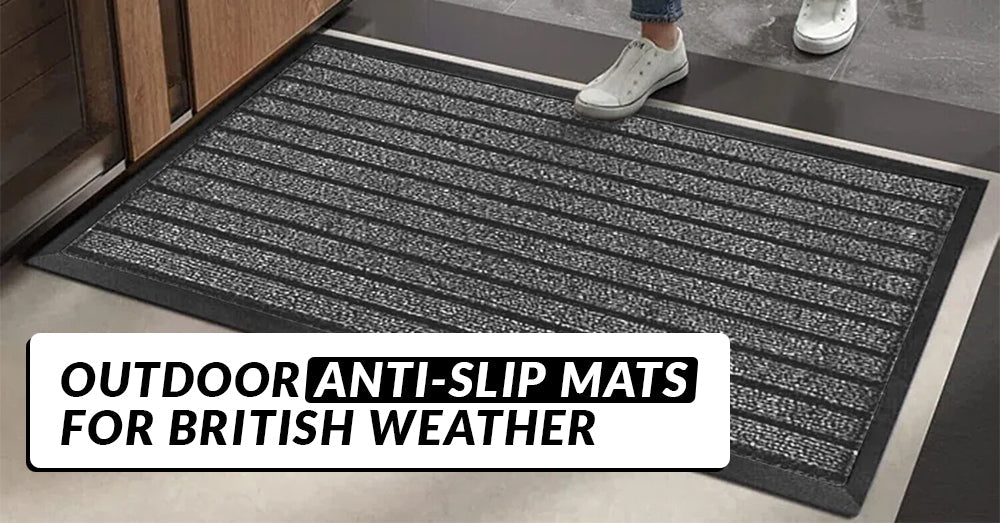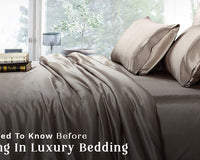Rain, drizzle, frost, sleet the UK gives us quite a mix of weather across the year. If you've ever slipped on a wet doorstep or icy patio, you know how treacherous it can be. Outdoor anti-slip mats can make a significant difference: they prevent accidents, protect surfaces, and even enhance the appearance of your home. In a nation where damp days are more norm than exception, choosing a mat that stands up to the elements isn't just a luxury — it's essential.
When you invite friends or family over, you want them to feel safe and confident as they walk in. You don't want them to tiptoe across slippery stones or patchy decking. A properly chosen anti-slip mat helps them (and you) feel secure. In addition to safety, the right mat enhances your exterior aesthetic blending colour, texture, and resilience. By the end of this guide, you'll feel confident in selecting an outdoor anti-slip mat that's suitable for British weather and your specific space.
Key Factors to Consider Before Buying

Material durability (rubber, PVC, composite)
Rubber is resilient, flexible, and provides a comfortable underfoot feel. It handles cold, flexes slightly, and is often easy to clean. High-density PVC or composite materials can be lighter and resist fading, though they might feel harder. Choose a material that flexes in cold, resists UV fading in sunshine, and stays stable under load.
Weatherproofing: UV, frost, rain resistance
Your mat will face rain, sun, occasional frost and even hail. UV stabilisers matter to prevent bleaching. Frost resistance is critical materials that become brittle in sub-zero weather will crack. Seek mats sold as "all-weather," "UV stabilised," or "frost resistant" in their specifications.
Drainage and water shedding features.
Flat mats can trap water underfoot, defeating the purpose. The best non slip shower mat for elderly include perforations, channels, holes, or elevated ridges to let rainwater or snow slush drain through or off the surface. This keeps the contact surface drier and safer.
Size, thickness, and weight
Thicker mats often feel sturdier and resist curling edges, but if they are too thick, they may create a trip hazard. Weight helps mats stay in place under wind or foot traffic, but very heavy duty rubber mats may be harder to handle during cleaning. Choose sizes that cover your high-risk zones without overshooting onto smooth surfaces.
Ease of cleaning and maintenance
You'll want to hose or scrub the mat periodically to keep it clean and fresh. Mats that can be lifted easily, don't trap dirt in deep convolutions, and are chemical-resistant make maintenance painless. Avoid mats with extremely tight patterns that trap moss or grit.
Aesthetic and colour considerations
You want a non slip shower mat that complements your brickwork, decking, or outdoor furniture. Earth tones, greys, or natural hues often integrate better than jarring colours. Textured finishes may add visual interest. Just remember: function must come first — safety over style.
Types of Outdoor Anti-Slip Mats

Decking mats
These are designed to sit over decking boards. They often have holes or ridges to allow water to pass through, grip the deck below, and provide a comfortable walking surface.
Entrance and doorway mats
These go right outside your door, under a porch or canopy. They need crisp edges to avoid catching shoes, and grip underneath so they don't slide when you pull them back to clean.
Balcony and terrace mats
Balcony mats may require drainage underneath to prevent water from pooling. They should be UV stable and capable of lifting for cleaning underneath (to prevent moss buildup).
Ramp and stair mats
These need excellent grip and must remain firmly anchored — especially on inclined surfaces. Grooved or high-friction surfaces are typical; strong mechanical anchoring is often recommended.
Choosing the Right Mat for Each Outdoor Space

At your front door or porch
Your doorway mat faces constant foot traffic, rain splash, and perhaps leaves and grit. Choose a mat with a textured, dense surface and a strong anchor underneath. A mat that collects debris but can be easily removed for cleaning is ideal.
On decking or garden paths
Decking mats should bridge gaps, allow airflow, and permit water to escape. They should not trap moisture under them, or you risk deck rot. Opt for mats that promote drainage and ventilation.
On balconies and terraces
Balcony mats often sit over tiles or concrete. They must avoid slipping on a flat base. Look for mats with anti-skid underlays or rubber nubs that grip the base surface.
On steps, ramps, inclines
Slope magnifies slip risk. You'll want aggressive texture, thickness (but not so much it becomes a trip), and mechanical fixing (bolts, clips). Choosing a mat with an edge lip helps prevent abrupt transitions.
Installing Outdoor Anti-Slip Mats
Surface preparation
Clean your surface thoroughly. Remove moss, algae, dirt, and ensure it's dry. A clean base helps adhesives and mechanical fixings perform better.
Fixing methods: adhesives, clips, screw down
Small mats might rely on heavyweight or grab mats. Larger ones often need adhesive, screws, or clips. The adhesive should be suitable for your substrate (wood, concrete, tile). Clips or screws give more reliable anchoring on inclines but may cause damage if misapplied.
Seasonal checks and re-securing
Over time, fastening weakens. Especially after freeze-thaw cycles, check that corners haven't lifted, clips are tight, and the mat remains flush. Reattach any loose parts promptly.
Caring for and Maintaining Your Mats

Routine cleaning (sweeping, hosing)
Weekly sweeping helps remove leaves, grit, and surface moisture. A garden hose spray (not too powerful) flushes off dirt.
Deep cleaning (pressure washing, mild detergents)
Occasionally, use a pressure washer on a light setting or a soft brush with mild detergent. Avoid harsh chemicals, which degrade rubber or PVC over time.
Winter care: frost, freezing, salt exposure
If you use salt to deice nearby, avoid mats that absorb salt (it can accelerate wear). Shake or lift the mats to remove snow or ice. Do not hammer or chip ice on the mat surface — it may scratch.
When to replace your mat
Once the mat no longer lies flat, shows cracks or brittle edges, or has lost its grip underfoot, it's time to upgrade. A failing mat is worse than none at all.
Common Mistakes to Avoid
-
Choosing a mat that is hard in cold climates so it does not crack under frost.
-
Using a mat without adequate drainage allows water to sit underneath, causing mould or rot.
-
Skimping on proper fixing leading to flipped edges or movement.
-
Selecting a design that clashes significantly with your outdoor aesthetic can be visually jarring.
-
Ignoring wear and not replacing early worn patterns loses grip gradually, sometimes imperceptibly.
Cost Considerations and Budgeting Tips
Expect a range, from affordable rubber mats for small doorways to premium modular systems for large decks or stairs. Cheap isn't always bad, but weigh the cost per year of use rather than the one-off cost. Spending a little more on UV, frost, and drainage features often pays dividends by doubling lifespan.
If you need several panels, buying a set or kit often brings savings. However, don't compromise on the anchoring method or quality just for a lower price. Always verify what's included (clips, adhesive, edge trims).
Real-Life Scenarios & Use Cases
Imagine heavy rain showers just after dawn. You step outside to let the dog out. A dryened anti-slip mat gives grip where wet tiles would be treacherous. Or think of winter: after a frost, rooftop terraces become icy. A well-anchored, textured mat turns a risky walk into a safe path. In high-traffic zones such as entrances used by children or visitors even small mats can prevent slips and boost confidence.
Conclusion & Buyer Checklist
Outdoor anti-slip mats can transform wet, icy, or slippery exteriors into safe, usable zones all year round. In the UK, where weather swings are the norm, selecting the correct mat requires attention to materials, drainage, anchoring, and maintenance. Use the following checklist before you commit:
Start small if you're unsure try one mat at a doorway and monitor how it copes with rain, frost, moss, and general wear and tear. You'll soon find what works best for your setting. With the right choice, you'll walk more safely, maintain your exterior, and worry less about wet days.
FAQs
Q1: Are all "anti-slip" mats equally good for UK weather?
No materials and design vary widely. A mat that performs well in a dry climate may fail under British rain or frost. Always check for UV stability, frost resistance, drainage, and grip features.
Q2: Can I use an adhesive to fix a mat permanently outdoors?
Yes, but choose an adhesive rated for outdoor use on your specific surface (wood, tile, concrete). Also consider how it may affect the substrate and allow for seasonal movement. Mechanical fixing is more secure in many cases.
Q3: How often should I clean my outdoor mat?
Light cleaning (sweeping and hosing) weekly or bi-weekly is good. Deep cleaning (pressure washing, scrubbing) should be done every few months, especially after storms or winter periods.
Q4: Will salt or de-icer damage my mat?
Some mats absorb salt, which accelerates degradation. Opt for materials that resist salt exposure or rinse the mat soon after de-icing.
Q5: Can I cut a large mat to fit my custom area?
Often yes — many mats are modular or can be trimmed with a sharp utility knife. Cut only carefully, following the manufacturer's guidelines, to avoid damaging edge seals or the structure.


